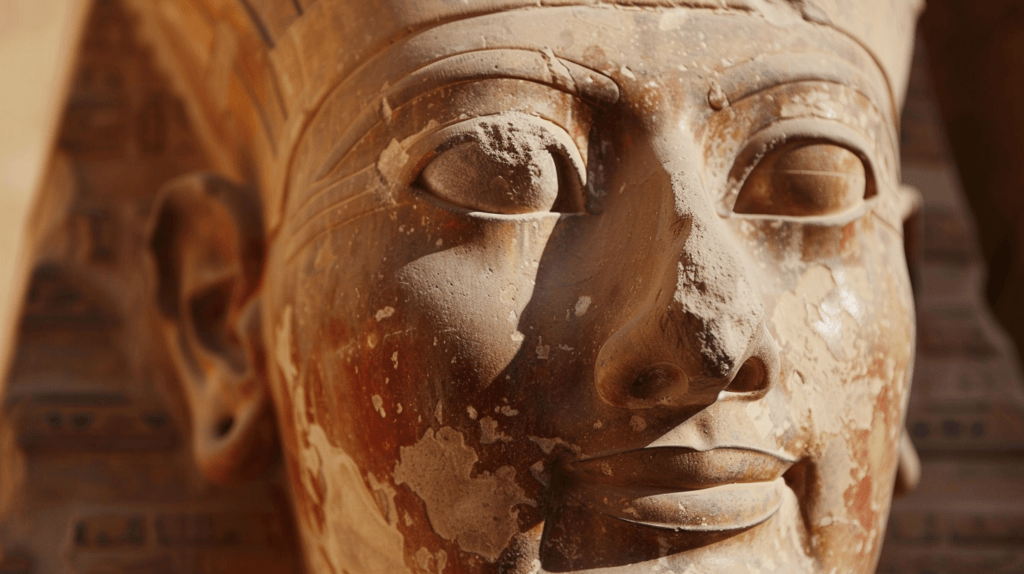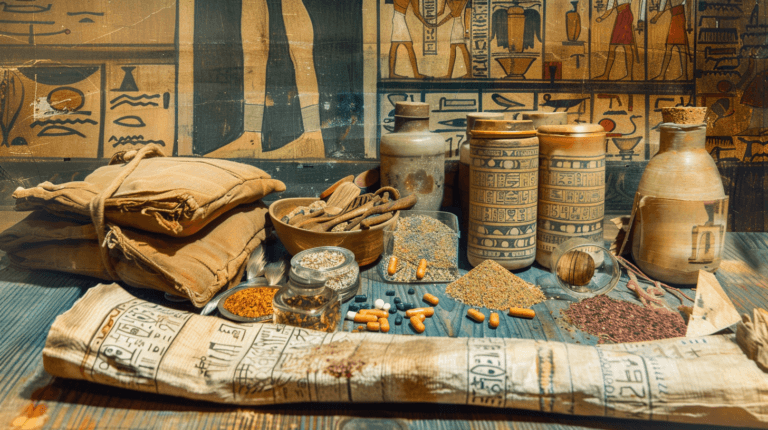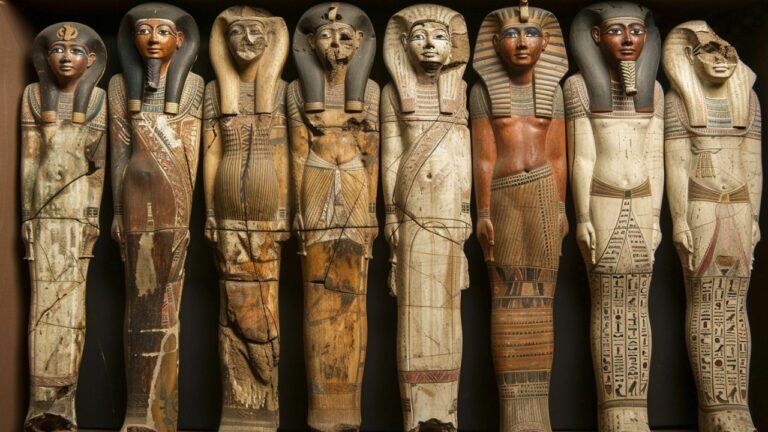Why Was Hatshepsut a Good Pharaoh?
When I think about influential rulers of ancient Egypt, Hatshepsut immediately comes to mind. Her reign challenged the norms of her time as she rose to power in a male-dominated role. As the daughter of Thutmose I, and eventually the wife of her half-brother Thutmose II, my understanding is that her pathway to the throne was initially forged through traditional connections within the royal family. When Thutmose II passed away, and her stepson Thutmose III was too young to rule, she seized the opportunity not just to act as a regent but decided to rule in her own right in the 18th Dynasty. So, why was Hatshepsut a good pharaoh?

Let me tell you, Hatshepsut was a rarity as a female pharaoh in the New Kingdom of ancient Egypt, but that’s not what only made my impression of her as ‘good’. It was her incredible ability to maintain peace and prosperity during her reign. She displayed sharp political acumen by assuming all the titles and regalia of a pharaoh. It was under her rule that Egypt enjoyed economic success and stability, which surely says something about her leadership qualities. Besides, she commissioned numerous construction projects and monuments, which left a lasting legacy that endures to this day.
Even more impressive to me is how she cleverly legitimized her position. Sure, she faced challenges in asserting her authority in a male role, but her monuments often depicted her with a male body and false beard, subtly reinforcing her position as pharaoh and illustrating her innovative approach to overcoming societal barriers. Her reign as pharaoh wasn’t just a seat-filler until Thutmose III came of age; she made it a point to be a significant and effective ruler in her own right. It’s no surprise that her name is still recognized and respected thousands of years later as a testament to her successful and unorthodox reign.
Key Leadership Qualities of Hatshepsut

Hatshepsut wasn’t just any pharaoh; she was a game-changer. Ever wondered what Hatshepsut would say about her own reign? Well, you’re in luck! In this article, we’re letting Hatshepsut do the talking, imagining how she might tell her own story. Dive in as we explore her life and times straight from the pharaoh’s mouth!
Political Acumen and Strategic Governance
As a female ruler in male-dominated ancient Egypt, I had to master the political game to earn and sustain my legitimacy.I understood that being a female pharaoh came with its challenges. So, I built my governance on astute political strategies. During periods of political crisis, my decisions were always about keeping Egypt stable.
I fortified my reign by re-establishing trade networks that had been disrupted and focused on building monumental architecture, which not only glorified my reign but also bolstered Egypt’s economy and culture. For instance, my expedition to the Land of Punt brought back wealth and exotic goods, which I used to boost my reputation among my people.
Maintaining Power: Hatshepsut’s Relationship with Thutmose III
Maintaining power was a juggling act, especially with Thutmose III in the picture as my co-regent and stepson. Instead of sidelining Thutmose III, I included him in my official imagery, showing a seamless co-regency.
My strategic approach softened my image and validated my role, ensuring that he was still seen as a legitimate heir. This not only quelled any potential dissent but also ensured a smooth eventual transition, contributing to Egypt’s stability.
Major Accomplishments of Pharaoh Hatshepsut

As one of Egypt’s most effective pharaohs, I, Hatshepsut, took great strides in leaving a legacy of architectural wonders and economic prosperity. My reign is marked by impressive construction projects and the bolstering of Egypt’s wealth through ambitious trade missions.
Architectural Innovations and Temple Constructions
My rule brought about significant architectural innovation, particularly in the construction of temples which showcased my devotion to the gods and goddesses of ancient Egypt. The Temple of Karnak, for example, saw great expansion under my command, reflecting my reverence and dedication to Amun-Ra. With the assistance of my trusted advisor and architect, Senenmut, these religious sanctuaries not only served as places of worship but also as monuments to my reign.
Senenmut and I didn’t stop there; we oversaw the creation of my masterpiece, the Mortuary Temple at Deir el-Bahri. This architectural marvel nestled in the cliffs on the west bank of the Nile, stands today as a testament to my vision and the skill of ancient Egyptian builders.
Boosting the Economy: The Famous Expedition to Punt
To enrich Egypt’s economy and secure precious goods, I launched a renowned trading expedition to the Land of Punt. This venture was a significant success, yielding a wealth of goods including gold, incense, ebony, and exotic animals. The detailed reliefs found in my mortuary temple depict this noteworthy achievement, marking it as one of the most well-documented trading expeditions in Egyptian history.
This undertaking not only brought back valuable resources but also strengthened our trade networks and economic influence throughout the known world. My reign was a golden era of prosperity brought on by these savvy economic moves and successful explorations in search of wealth and resources.
Cultural Impact and Religious Contributions
Before diving into the specifics, let me highlight why Hatshepsut’s reign was a defining era for Egypt’s cultural and religious advancements. She not only commissioned countless architectural wonders but also enhanced religious practices, leaving a lasting legacy.
Hatshepsut’s Influence on Egyptian Art and Architecture
During my time as pharaoh, I made significant strides in Egyptian art and architecture. I commissioned the construction of the majestic Deir el-Bahri, my monumental temple complex. It is here that you can see the fusion of architecture with natural landscape, something which I believed reflected harmony and balance.
- Obelisks: I erected towering obelisks at the Karnak temple complex, and ensured they were carved with intricate hieroglyphics to praise the gods and record my own achievements.
- Art: The influence on art was profound; the relief sculptures and intricate wall carvings during my tenure showcased a blend of realism with traditional regal iconography, setting a new artistic precedent.
Promoting Amun: Religious Initiatives and Their Significance
My devotion to Amun, the chief deity, was unwavering. I invested heavily in the expansion of Karnak, one of the most important religious complexes dedicated to this god. This was not just about showcasing my piety; it was also about centralizing religious and political power.
- Priesthood of Amun: By backing the priesthood, I consolidated my power and amplified the status of Thebes as Egypt’s spiritual heart.
- Rituals and Festivals: I revitalized sacred rituals and festivals, reiterating the importance of Amun in the social and religious fabric of the time.
In my architectural and religious ventures, the emphasis was always on glorifying the pantheon of Egyptian gods, with Amun at the pinnacle, thereby reinforcing the divine order of the universe as well as my place within it.

Analyzing Hatshepsut’s Legacy
The Impact of Her Policies on Future Pharaohs
Hatshepsut’s policies significantly shaped Egypt’s governance and culture well beyond her reign. Her architectural innovations inspired her successors, enhancing temples and infrastructure she began. Her era of stability and prosperity elevated Egypt’s regional power, affecting future diplomatic and trade policies and demonstrating the benefits of peace over conquest.
Rediscovering Hatshepsut: Restoration Efforts and Historical Reevaluation
After centuries of obscurity due to the erasure of her monuments and records, modern archaeological and scholarly efforts have reinstated Hatshepsut in history. These efforts have not only physically restored her monuments but also reevaluated her societal contributions, reestablishing her as a central figure in ancient Egyptian studies.
Controversies and Challenges of Her Reign
The Gendered Portrayal: Why Hatshepsut Chose to Be Seen as a Male
Hatshepsut portrayed herself with male attributes to solidify her authority in a patriarchal society. This was more than a personal choice; it was a strategic state policy aimed at legitimizing her rule and minimizing resistance based on gender by aligning with traditional pharaonic imagery.
Historical Erasure: The Omission from Ancient Records
The posthumous omission of Hatshepsut from records, likely instigated by Thutmose III, aimed to reassert male dominance and minimize the precedent of a successful female pharaoh. This act reflects the era’s gender biases and underscores the challenges she faced.
Why Was Hatshepsut a Good Pharaoh?
Hatshepsut combined wise governance with ambitious projects, enhancing Egypt’s prosperity and cultural standing. Her peaceful and economically stable reign marks her as one of ancient Egypt’s most effective leaders.
Hatshepsut’s reign highlights the importance of vision, innovation, and inclusive leadership in governance. Her story exemplifies that leadership qualities transcend gender, encouraging modern leaders to pursue unconventional paths for effective governance. Hatshepsut’s rule, marked by significant cultural contributions and strategic governance, established a lasting legacy, reinforcing her status as a pivotal and effective ruler in ancient Egyptian history.
Frequently Asked Questions
- Is Hatshepsut related to Tutankhamun? Hatshepsut and Tutankhamun were both part of the 18th Dynasty but were not directly related. They share a dynastic connection but no direct familial ties.
- Was Hatshepsut in the Bible? Hatshepsut does not appear in the Bible. Her reign in the 15th century BCE is separate from the events and figures mentioned in biblical texts.
- Who were Hatshepsut’s parents? Hatshepsut was the daughter of King Thutmose I and Queen Ahmose, which solidified her royal claim to the Egyptian throne.
- Did Hatshepsut have any children? Hatshepsut had a daughter, Neferure, who played significant roles in her reign. There is no evidence of surviving sons who could succeed her.







